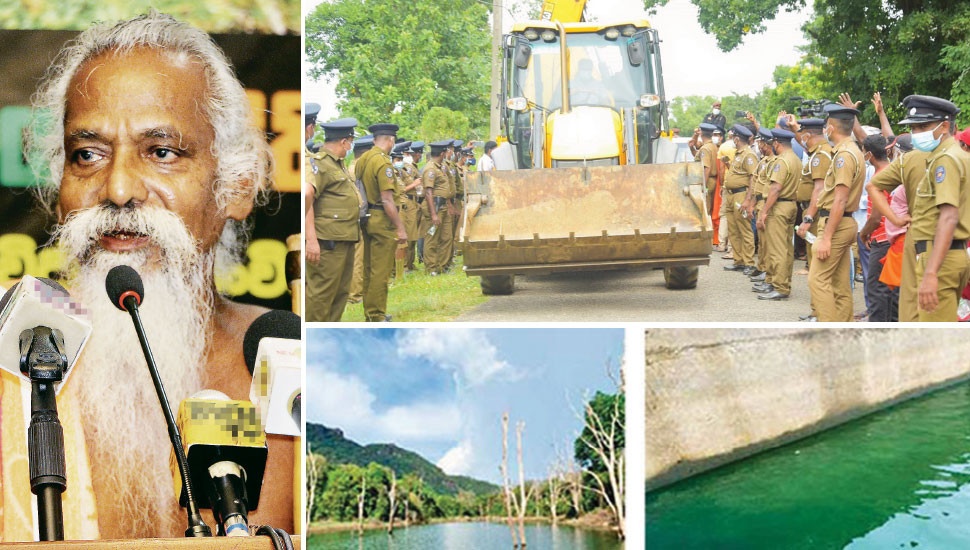By Gagani Weerakoon
Karunawathie belongs to a community that represents the poorest of the poor in Sri Lanka and lives in Uva Wellassa, one of the least developed areas. She has been paying land tax (Akkara Badda) for the land she seeks a shelter and cultivates to earn her family a daily pot of rice. However, she was recently informed that the land she was living on, no longer belongs to her, and in fact will be taken away from her to be invested in a “promising” multinational project of cultivating sugarcane.
Meanwhile, Karunawathie and others in Dehigama, Ridimaliyadda are now facing a bitter future, of having to consume contaminated water, increased human-elephant conflicts and in the long-term of being categorised as households with Chronic Kidney Disease of Unknown Aetiology (CKDu).
Those in Dehigama are concerned, as their neighbours, who belong to the indigenous Vedda community, risk losing their traditional lands, and the only water resource they had access for potable water, Rambakan Oya, being highly polluted and contaminated as a result of a similar multinational project of maize.
Background
In 2006, an area of land with a total extent of 65,000 acres in 11 Divisional Secretariat Divisions of Ridimaliyadda, Madagama, Bibile, Kandakatiya, Lunugala, Padiyathalava and Mahiyangana in the Badulla, Ampara and Monaragala Districts was earmarked for a sugarcane plantation project.
JVP Central Committee member Samantha Vidyaratna said the first company who intended to carry out the said project was a British multinational company. He added however when the initial project proposal was made, conservationists, after having inspected the aerial view of the plot of 500 acres land in Osu Uyana Aranyaya (Monastery), Nilgala Forest required for the construction of a sugarcane factory, protested against the move, observing that this land comprises a sensitive forest reserve.
He noted this was followed by a Chinese multinational company whose efforts were also defeated, adding that it was after these failed attempts, that the same project is being attempted to be brought forward in cooperation with a Singaporean company.
“The company then looked for alternative lands in the Monaragala District and such effort was also opposed as the proposed land formed part of the Gal Oya National Park following which land in Dehigama was considered for the commencement of the long proposed project,” he added.
Senior adviser to the Centre for Environmental Justice (CEJ) and chair of friends of Earth International, Hemantha Withanage said in 2013, an Environmental Impact Assessment (EIA) was conducted on 300 hectares of land in Dehigama for a sugarcane factory, a power station and a plant nursery required for sugarcane which were all part of the project.
Withanage noted 300 hectares was only a portion of the total land required by the project for the construction and thereby the EIA has only been conducted on part of the land as opposed to the whole land as required by law. In addition to this, the company also required 3,000 hectares of land for Gliricidia, which would be used to establish a 16 MW power plant.
Concerns
The land proposed to be utilised in this project has been recognised as a ‘special area’ in terms of the Sri Lanka Mahaweli Authority Act No. 23 of 1979.
Majority of the lands consists of ‘Other State Forests’ governed under Section 20 of the Forest Ordinance (as amended) and located between Maduru Oya National Park and Gal Oya National Park, Nilgala Forest and Other State Forests in Puwakpale Reserve Forest which is an elephant corridor and has been an elephant habitat for a considerable span of time.
Vidyaratna added apart from the environmental impact of the project, implementation of this project will result in sociological issues, as this area is home to the indigenous population, while the people in the area will also be exploited through cheap labour that would in turn impact their standard of living.
Monoculture
There are currently a number of chena cultivations in the area which have been traditionally done by farmers paying a tax (Akkara Badda) to the Mahaweli Development Authority and the proposed sugarcane plantation will deprive them the arable lands for chena cultivation.
Vidyaratna said according to the Cabinet Paper submitted for the proposed project, a hectare of land will be handed over to farmers for a commercial tax for the cultivation of only sugarcane, resulting in monoculture.
Designating 65,000 acres of land for a monoculture cultivation such as sugarcane can lead to unsustainable environments such as building up diseases pressure and degradation of the soil (reducing particular nutrition in the soil) resulting in the excessive use of chemical fertilisers and pesticides, the CEJ said.
Furthermore, the reuse of the same soil instead of following a determined crop rotation can lead to pathogens and diseases in a large expanse of land.

Impact on environment and elephant corridor
There are several areas of a great environmental value in this proposed area including the Nilgala Reserve, Gal Oya National Park, Maduru Oya National Park and also comprises several irrigation systems and if forest reserves are cleared, the water sources will also be immensely polluted, Vidyaratna said.
The CEJ observed there is an imminent threat of the water resources in the area drying up if the forest areas are being cleared to make way for the sugarcane cultivation, and sugarcane also absorbs a lot of water for its growth and this would convert fertile land into a parched desert in a short span of time.
The movement of elephants to Kumana National Park through Nilgala and Puwak-kele Forest Reserve and from the elephant corridor between Dehigama and Akiriyankumbura will be obstructed if the land is cleared and utilised. Elephants will loiter into villagers in search of food, further aggravating the human-elephant conflict.
Archaeological sites
Vidyaratna also noted that in the land proposed for the construction of the sugarcane factory, over 7 archaeological sites were identified. He added that several petitions were signed when a Cabinet Paper was submitted during the former Government and a Petition was also signed with blood by clergy and those who were genuinely concerned with the implementation of the project.
Laws
Section 20 of the Forest Conservation Ordinance No.16 of 1907, as amended, provides for the acts prohibited in any such forests. As per the Sub Sections 20 (f) and (k), making any clearings and clearing or breaking up soil or digging any land for cultivation or any other purpose or cultivating any land already cleared is expressly prohibited and penal sanctions have been imposed for non-compliance and for aiding and abetting.
Due to the express prohibition spelt out in Section 20 of the Forest Conservation Ordinance No. 16 of 1907, such lands cannot in any manner whatsoever, be cleared and/ or be utilised for cultivation purposes.
Further, in terms of Section 22 of the Mahaweli Authority of Sri Lanka Act, any written laws specified in Schedule B thereto shall have effect in every Special Area subject to the modification that it shall be lawful for the Authority to exercise and discharge in such area any of the powers or functions vested by any such written law in any authority, officer or person in like manner as though the reference in any such written law to the authority, officer or person empowered to exercise or discharge such powers or functions included a reference to the Authority.
The Forest Ordinance has been listed under Schedule B of the Mahaweli Authority of Sri Lanka Act and hence, the Section 20 of the Forest Ordinance as amended shall have effect in Special Areas which falls under the preview of the Mahaweli Authority of Sri Lanka.
Other sugar factories
The Movement for Land and Agricultural Reform (MONLAR) moderator Chinthaka Rajapaksa said there are already four sugar industries that have been isolated and the land in which these industries have been set up, has been completely destroyed, adding that not even 10 per cent of the local sugar need in the country has been met through these four industries. He said thereby the current efforts are also for fraudulent income-earning mechanisms.
Rajapaksa said lessons have to be learnt from the past, as former similar projects have failed, and clearing of forests in areas of high environmental value has not in any manner contributed to the economy, and has also not enhanced the lives of those living in these areas.
He added that if there is any intention to develop these lands, the ongoing cultivation of different crops should be facilitated better instead of approving and implementing such projects that push farmers to practice monoculture.
Impact on Vedda community
Leader of the Vedda community, Uru Warige Wannila Aththo said within the lands required for the entire project, there are forest reserves that contain medicinal plants that are of great value for Ayurvedic treatment. He added that the waste of sugar factories will be discharged to the water sources and those inhabiting the area, including the Vedda population will not be able to consume this water, as it will have a huge impact on their health as well as on the agricultural practices in the area.
He added that there are several who voice in favour of environment conservation, but at the pace that forests are being cleared for development purposes, there will hardly be any forest reserves even for the indigenous population who have been hugely dependent on such forests. “The indigenous population has already faced a huge crisis with the clearing of lands in Pollebedda, which has contaminated the Rambakan Oya,” he said, adding that this proposed project will however result in a much worse impact on them.
The Rambakan Oya is an embankment dam in Maha Oya and currently functions under the directions of the Ministry of Irrigation and Water Resource Management. The Rambakan Oya Reservoir Project is a multipurpose irrigation project that aims to remedy the drinking water and irrigation problems in the area.
Continuous concerns were in the past raised in regard to a proposed agriculture and livestock development project that was proposed to be implemented by clearing the water catchment area of the Rambakan Oya Reservoir.
Withanage said initially it appeared as though the direct impact of clearing the forest reserve was the environmental destruction and the risk it posed to the livelihood of the indigenous population in the area, but the broader picture was later discovered with the growth of Cyanobacteria in the Rambakan Oya Reservoir after the lands were cleared for maize cultivation.
It was noted that the Cyanobacteria content identified in Rambakan Oya is also higher than that normally contained in a reservoir and in certain countries when this is over the value of 20,000, a public announcement will be made, advising not to use that water for any purpose, but that the Rambakan Oya’s Cyanobacteria value is over 40,000. Cyanotoxin in Rambakan Oya is also higher than the standard and this could not be expected from a recently established reservoir.
This story was produced as part of a journalism fellowship under CIR’s ‘Stories from the Margins” initiative supported by the Earth Journalism Network (EJN) and Internews. It was originally published on Ceylon Today newspaper.




